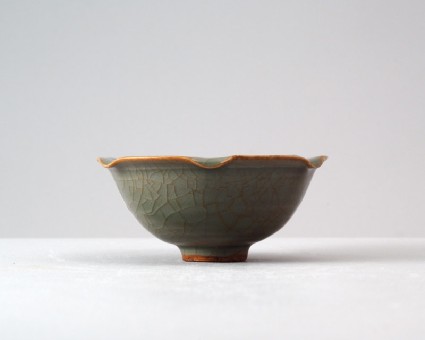The Barlow Collection
A select catalogue of the Barlow collection of Chinese Ceramics, Bronzes and Jades by the University of Sussex (published Sussex, 2006).

Publications online: 456 objects
Greenware bowl with lotus leaves and a tortoise
- loan
-
Literature notes
The well-rounded bowl has a narrow tapering foot and pointed base, and a widely flaring rim with has been bent down in six places, to suggest a curled leaf. The inside has been incised with veins to depict a lotus leaf, a central raised boss has been turned into a tiny tortoise by application of slip to indicate head, tail, legs and markings of the carapace. The translucent, dark green glaze is highly glossy and watery and forms a thick glassy layer in the down-curved areas of the rim; in between and on the base, where it has drained away and is very thin, it has fired a yellowish-brown, which forms an interesting contrast to the green. The outside is undecorated and has an attractive crackle. The footring is also yellowish-brown. -
Details
- Associated place
-
Asia › China › Zhejiang province › Longquan kilns (place of creation)
- Date
-
13th century (1201 - 1300)
Southern Song Dynasty (1127 - 1279)
- Material and technique
- stoneware, thrown, with incised and slip decoration under a green crackled glaze; glazed base; glazed rim
- Dimensions
-
5.2 cm (height)
11.5 cm (diameter)
- Material index
- Technique index
- Object type index
- No. of items
- 1
- Credit line
- Lent by the Sir Alan Barlow Collection Trust.
- Accession no.
- LI1301.280
-
Further reading
University of Sussex, and Arts and Humanities Research Council, The Barlow Collection, supervised by Regina Krahl, Maurice Howard, and Aiden Leeves (Sussex: University of Sussex, 2006), no. C275
Glossary (3)
glaze, slip, stoneware
-
glaze
Vitreous coating applied to the surface of a ceramic to make it impermeable or for decorative effect.
-
slip
A semi-fluid clay applied to a ceramic before glazing either to coat the surface or for decorative effect.
-
stoneware
Ceramic material made of clay which is fired to a temperature of c.1200-1300⁰c and is often buff or grey in colour.
Location
-
- currently in research collection
Objects are sometimes moved to a different location. Our object location data is usually updated on a monthly basis. Contact the Jameel Study Centre if you are planning to visit the museum to see a particular object on display, or would like to arrange an appointment to see an object in our reserve collections.
Publications online
-

The Barlow Collection
The well-rounded bowl has a narrow tapering foot and pointed base, and a widely flaring rim with has been bent down in six places, to suggest a curled leaf. The inside has been incised with veins to depict a lotus leaf, a central raised boss has been turned into a tiny tortoise by application of slip to indicate head, tail, legs and markings of the carapace. The translucent, dark green glaze is highly glossy and watery and forms a thick glassy layer in the down-curved areas of the rim; in between and on the base, where it has drained away and is very thin, it has fired a yellowish-brown, which forms an interesting contrast to the green. The outside is undecorated and has an attractive crackle. The footring is also yellowish-brown.
Notice
Object information may not accurately reflect the actual contents of the original publication, since our online objects contain current information held in our collections database. Click on 'buy this publication' to purchase printed versions of our online publications, where available, or contact the Jameel Study Centre to arrange access to books on our collections that are now out of print.
© 2013 University of Oxford - Ashmolean Museum




